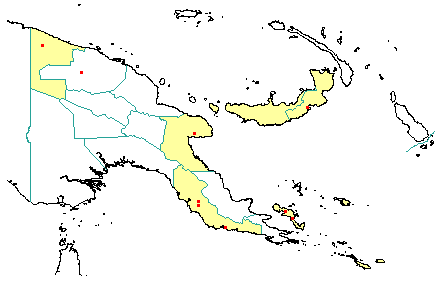
in PNGplants database
PNGTreesKey – Canarium oleosum (Lam.) Engl. |
Barry Conn (NSW) & Kipiro Damas (LAE).
Guide to trees of Papua New Guinea
Copyright held by the authors, National Herbarium of New South Wales, and Papua New Guinea National Herbarium
in Engler & Prantl, Die Natürlichen Pflanzenfamilien 3, Vol. 4: 241 (1896) Fig. 136.
Other Literature: P.W. Leenhouts, Flora Malesiana, Series 1, 278-279 (1956) Fig. 20-21-41.
Family: Burseraceae
Dicotyledon
Timber Group: Commercial hardwood Tradename: Grey Canarium
Field Characters: Large canopy tree (12-20 m high, rarely to 30 m) or Small sub-canopy tree; Bole cylindrical; straight; buttresses buttresses present; spines spines absent; aerial roots aerial roots absent; stilt roots stilt roots absent; Bark grey, rough or slightly smooth, scaly or flaky or pustular, rarely lenticels rounded/swelling or lenticels irregular; Subrhytidome (under-bark) green; less than 25 mm thick; bark blaze consisting of one layer; outer blaze rarely pink or red, markings absent, fibrous; inner blaze pink or rarely brown, markings absent, fibrous; bark exudate (sap) present, colourless, not readily flowing (spotty), colour not changing on exposure to air, sticky; terminal buds enclosed by leaves (bracts) or not enclosed by leaves.
Indumentum: Complex hairs absent; stinging hairs absent; mature twig indumentum (hairs) present when young or later absent, hairs sparse.
Leaves: Leaves spaced along branches, spiral (leaves occurring singly at a node and arranged spirally up the branchlet), compound (a leaf made up from two or more leaflets); petiole present, not winged, attached to base of leaf blade, not swollen; leaves palmate (with more than three leaflets attached at one point to the stalk); petiolule not swollen; leaves broadest at or near middle, 6.0-7.0 cm, 2.0-2.5 cm, leaflets opposite, symmetric; venation pinnate, secondary veins open, prominent, intramarginal veins absent; leaves lower surface pale green, upper surface dark green, indumentum (hairs) absent; absent; domatia absent; stipules absent.
Flowers: Inflorescence axillary, flowers on an unbranched axis or flowers on a branched axis, cones absent; flowers unisexual, unisexual with male and female flowers on the same plant, stalked, flowers with many planes of symmetry, 5.0-7.0 mm long, diameter small (up to10 mm diam.); perianth present, with distinct sepals and petals whorls, inner perianth green (olive green); 3, free; stamens 6, present, free of each other or at base joined, free of the perianth; ovary superior, carpels joined (when more than one), locules 3; styles solitary (reduced in male flowers), 1.
Fruits: Infrutescence arranged on unbranched axis or arranged on branched axis, fruit 12.0-20.0 mm long, purple, not spiny, non-fleshy, simple, indehiscent, drupe; seeds 1, not winged, narrow (longer than wide), seed 1-10 mm diam. (c. 10 mm diam.).
Distribution: West Sepik, Morobe, Central, Papuan Islands & New Britain.
 | Botanical records in PNGplants database |